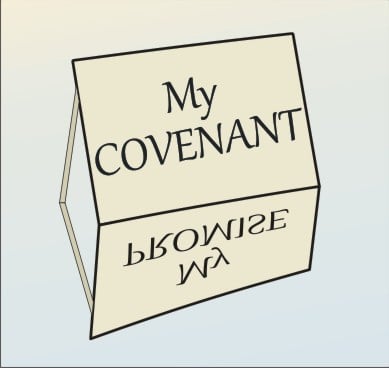What Is a Covenant?
 In this sin-ridden world we, keeping a promise is not looked upon with much respect. Therefore, in order for society to insure that promises would be kept, man has devised simple ways to enforce such things. Two of those ways are the ancient covenant and today’s contract.
In this sin-ridden world we, keeping a promise is not looked upon with much respect. Therefore, in order for society to insure that promises would be kept, man has devised simple ways to enforce such things. Two of those ways are the ancient covenant and today’s contract.
The difference between the two of them basically lies in the range of implementation and the way they are ratified or sealed. A contract is usually between two parties and can be either one-sided or two-sided – meaning that the second party either has something to say in the contract, or it doesn’t. A couple of examples of one-sided contracts are the pledge to give money and the promise to marry. Neither one requires a response from the second party but is always considered legally binding (at least in the US).
Unlike a contract, a covenant can be a one-party, one-sided instrument, where the one party determines a course of action that may affect another party which has absolutely no say in the matter. Covenants such as the plan of salvation, devised before anything was created, and the promise of Christ’s Second Advent form one-party, one-sided covenants. It doesn’t matter what we think of these. God has promised, and He is going to do it, no matter what.
The Seventh-day Adventist dictionary further classifies the types of covenants into a covenant between equals and a covenant between vassal and lord. The first usually involves negotiated benefits both sides receive. It is this type that we usually call a contract. A good example would be purchasing something from a store or getting a loan from a bank. Both sides benefit by the transaction. The store gets money for the purchased object, and the buyer gets the object. When a borrower gets a loan, he ends up with an instant fist full of money while the bank makes money on the deal through an amount of interest the borrower agrees to pay for the service.
The second type (lord – vassal) usually involves a set of conditions stated by the lord that the vassal must keep in order to receive some benefit, if any, from the lord. A treaty is a good example of this type where one party has been totally conquered by the other which becomes its lord. All of the covenants between man and God are of this type, and, with few exceptions, involve the Lord commanding a certain set of requirements, either explicitly or implicitly, to be met by man in order for him to receive any stated benefits.
The core of the covenant is the promises that are between the parties. The promises always involve benefits to one or more of the parties. Many people become confused in thinking that a covenant is the benefits rather than the promise involving them. For this reason the book of Hebrews speaks of “better promises” rather than better laws (Hebrews 8).
After an agreement has been reached, whether it is a covenant or a contract, it was often sealed or ratified. Today that is usually done with a signature by both parties but in ancient times major ones were usually done with blood. A prime example of the ancient way of doing this is the covenant made between God and Abraham (Gen 15). The Seventh-day Adventist Commentary describes what was done in Volume 1, page 313:
9. Take me an heifer. God condescended to enter into a solemn covenant with Abram, in a form customary among the ancients. The expression “to conclude” or “to make” a covenant (v. 18), literally, “to cut” a covenant, was derived from the practice here described. The animals Abram was directed to use were precisely those later prescribed as sacrificial beasts by Moses (see Ex. 29:15; Num. 15:27; Num. 19:2; Deut. 21:3; Lev. 1:14). The requirement that the quadrupeds were to be “three years old” specifies mature animals.
10. Divided them in the midst. Each of the three animals was slaughtered and divided, and the two halves placed one against the other, with a space between. The birds were killed, but not divided. One was probably laid on one side, and the other opposite it. Those entering into the covenant were to walk between the divided pieces, symbolically vowing perpetual obedience to the provisions thus solemnly agreed upon. The lives of the animals pledged the lives of those participating in the covenant. This practice remained in force for many centuries, for we find it practiced in Jeremiah’s time (Jer. 34:18, 19).
Another view of the act of ratification by blood is the ratification of the Old Covenant at Sinai, “And Moses took the blood, sprinkled it on the people, and said, ‘This is the blood of the covenant which the LORD has made with you according to all these words’” (Ex. 24:8 NKJV). Which the SDA Commentary says, “Because blood symbolized the life of the victim (Lev. 17:14) it was an essential part of every sacrifice, and the sprinkling of it upon the altar was a focal point of the usual sacrificial ritual (Lev. 1:5; Lev. 3:8). Now, half of the blood was apportioned to the people and half to God, the blood sprinkled on the altar binding God, in symbol, and that sprinkled on the people binding them to the terms of the covenant (Heb 9:18-22; see also on Gen 15:9-13, 17) (SDA Bible Commentary, Vol 1, p 631).
The two main things to remember about covenants are that the promises are what make the covenant rather than the objects they deal with and that the major covenants between man and God involved blood as a means of ratification.
